Under Oaks
How to Choose | Extra Easy | Trees & How to Choose | Shrubs, Perennials, Groundcovers & Grasses | Plants for Common Marin Settings | CA Native Plants | Deer Resistant Plants | Plants for Pollinators | Succulents & Low Water | Lawn Alternatives | Ferns & Shade Plants | Houseplants | Plants to Avoid | Plant Terms
Gardening Under Oaks

There are 20 oak trees native to California. These stately trees create iconic landscapes, live up to 400 years, and provide tremendous benefits. Oaks are good investments -- for homeowners and the environment. By following a few guidelines, landowners can preserve their oaks for generations to come.
USE OUR PLANT LIST: > PLANTS THAT THRIVE UNDER OAKS
Whether you inherited a heritage oak or are considering adding one to your landscape, be sure to keep the environment under the canopy healthy.
Guidelines for planting in oak understories
• Native plants that naturally occur with oaks are good choices.
• Plant as far away from the trunk as possible.
• Avoid plants that require summer water once established.
• Avoid plants that require fertilizer.
• Do not use sprinklers. To get plants established, use drip irrigation.
• Plant in fall before winter rains.
• Be fire-smart.
Benefits of oak trees
Biodiversity: Oak woodlands are among the most biodiverse ecosystems in California.
Habitat: Oaks are habitat heroes. They are visited by hundreds of insects, birds, and animals, and provide food for more moths and butterflies than any other plant.
Cleaner air: Because of their girth, oaks absorb significant quantities of airborne pollutants.
Cleaner water: Oaks absorb fertilizer, pesticides, and other trace contaminants in soil, which reduces these pollutants in our water.
Erosion control: Large tree canopies and dropped oak leaves help prevent soil erosion by buffering the impact of rainfall.
Enriched soil. Soil under oak canopies is high in organic material, which increases the carbon storage capacity. This helps mitigate climate change.
Other benefits: Shade, shelter, increased property value, food, fuel, recreational activities
Precautions when gardening under oaks
Don't disturb roots. Keep the area from the trunk to the edge of the canopy (the root zone) as natural as possible. Avoid heavy foot traffic, parked cars, trenching, construction, or anything that compacts the soil or raises the grade. This includes solid hardscape surfaces. Choose gravel or other permeable surfaces instead.
Don't remove dropped leaves, which support microorganisms that help protect oaks from disease.
Don't irrigate. Oaks want it wet in winter and dry in summer. Oak bark is not adapted to summer moisture, and wet summer roots are prime candidates for deadly diseases. Most oaks die within ten years if irrigated in summer.
Don't fertilize. Feeding oaks may stimulate excessive leaf growth and encourage pest problems. Improperly applied, it can injure roots or burn foliage.
Prune evergreen oaks judiciously and only during dry weather when open cut wounds are less susceptible to infection. Remove as little foliage as possible. Keep cuts small.
Prune deciduous oaks when dormant in winter.
Don't overdo it: mature oaks typically do not require pruning.
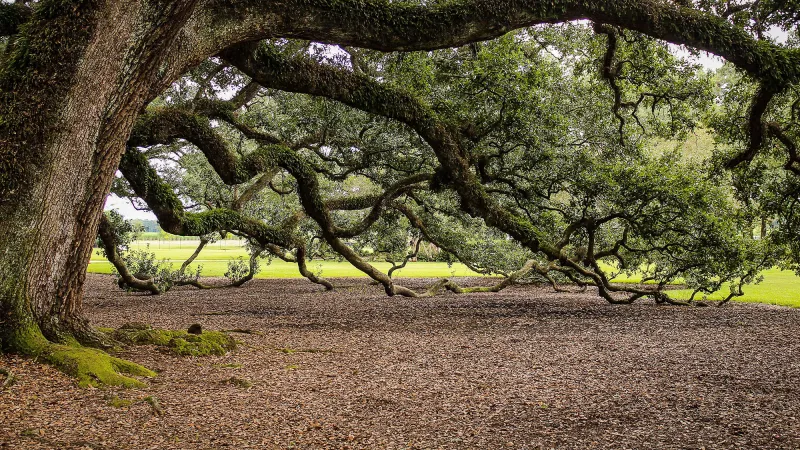
Common Oak Trees in Marin County
There are eight oaks native to the North Bay region. Each has its own distinctive growth habits, bark color, leaf structure, acorn color and shape. The coast live oak, California black oak, valley oak, Oregon white oak, and blue oak are the most common native oaks found in Marin County. Here’s how to determine what’s growing on your favorite trail — and maybe even in your backyard.
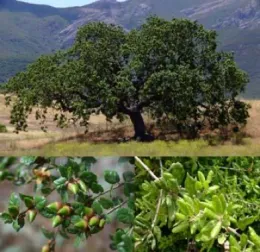
Coast Live Oak (Quercus agrifolia)
The coast live oak is an evergreen tree that typically has a multiple-branched trunk and a broad, dense crown with foliage often reaching the ground. A typical tree can reach 20 to 40 feet tall and live for 125 to 250 years. Smooth gray bark splits as it ages. The roundish, cup-shaped leaves are 1 to 3 inches long and spiny-tipped, typically dark green and shiny above and gray, rusty, and fuzzy underneath.
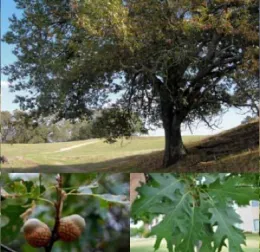
California Black Oak (Quercus kelloggii)
The California black oak is a deciduous tree with a broad and round crown, its lower branches nearly touching the ground. These trees grow 60 to 90 feet tall and have smooth gray young bark that becomes deeply furrowed and dark brown to black as it matures. They usually live 100 to 200 years. Leaves are 3 to 7 inches long, dark yellow-green above and pale yellow-green below, cut into five to seven lobes with a soft bristle on the tip. This oak is also known as the kellogg oak.
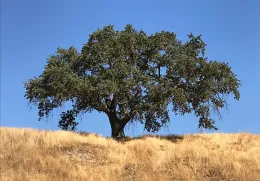
Valley Oak (Quercus lobata)
Valley oaks are deciduous trees 40 to 120 feet tall with deeply checkered gray-brown bark. They live 200 to 250 years. In advancing age, the branches droop, arch, and take on irregular shape. The deeply lobed eaves are 2 to 4 inches long, leathery, shiny dark green-yellow above and grayish below. This oak is also known as the California white oak. Photo: Creative Commons
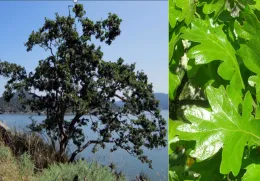
Oregon White Oak (Quercus garryana)
Oregon white oaks are deciduous trees 50 to 80 feet tall with thin, ridged, grayish-brown bark. They live 100 to 200 years. Leaves are 4 to 6 inches long, shiny dark green above and pale green below, with even and deep lobes. This tree looks similar to the valley oak. To distinguish between the two, check out the acorns. Valley oak acorns are long, narrow, and pointed, while white oak acorns are more rounded. This oak is also known as the Garry oak.
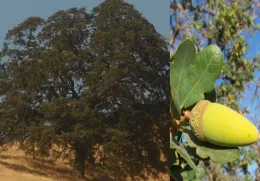
Blue Oak (Quercus douglasii)
The blue oak is a deciduous tree that typically has a broad, dense crown. A typical tree is 20 to 60 feet tall with gray-brown checkered bark. These trees live for 175 to 450 years. The powdery blue-gray leaves are 1.5 to 3 inches long and oval, with rounded tips and wavy or slightly lobed edges.
About Sudden Oak Death (SOD)
• SOD is a devastating plant disease that has killed over a million oak trees.
• It is caused by Phytophthora ramorum, a pathogen that thrives in cool, moist climates.
• SOD cases may increase as weather extremes increase.
Steps to avoid SOD
• Avoid infested SOD areas and muddy soil during rainy weather.
• If you enter an infested area during wet weather, scrape off any mud, soil, leaves, or other organic material from yourself as well as your pets and vehicle.
• Don’t collect or transplant host plants from infested or quarantined sites.
• Keep vehicles on paved surfaces during wet weather.
• Avoid doing yard work in rainy weather.
• Consider hiring a qualified arborist to treat susceptible oaks with a phosphonate fungicide annually
Learn more about Sudden Oak Death
